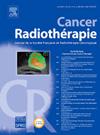Electron radiation therapy: Back to the future?
IF 1.4
4区 医学
Q4 ONCOLOGY
引用次数: 0
Abstract
Electron radiotherapy has long been preferred to photons for the treatment of superficial lesions because of its physical characteristics (high dose at the surface, rapid decrease in depth). Other characteristics (penumbra, heterogeneity on an oblique or irregular surface) make them difficult to use. In most indications (skin cancers, head and neck, medulloblastoma), with technical progress, in some cases they have been replaced by intensity-modulated conformal radiotherapy, brachytherapy and contact therapy. Other indications (drainage of mesotheliomas or irradiation of benign lesions) have disappeared. The low frequency of use leads to problems of safety and cost-effectiveness. However, modern photon radiotherapy techniques are still less effective than electrons in specific indications such as total skin irradiation (mycosis fungoides) or certain thin chest wall irradiations after total mastectomy, reirradiation or paediatric treatments without protons. Flash therapy, initiated by electrons, has been developed over the last 10 years, providing high-dose irradiation in an extremely short time. Initial results show good efficacy, with fewer side effects than with conventional radiotherapy. These results are leading to clinical technological developments on a larger scale. Although it has been replaced in most indications by more modern techniques, electron radiotherapy remains essential for targeted indications in specialised centres. The emergence of flash therapy will lead to new indications, on machines equipped with this new technology, which have yet to be defined and are currently the responsibility of specialised teams.
电子放射治疗:回到未来?
在治疗浅表病变方面,电子放疗因其物理特性(表面剂量高、深度下降快)一直以来都比光子放疗更受青睐。其他特点(半影、斜面或不规则表面的异质性)使其难以使用。在大多数适应症(皮肤癌、头颈部肿瘤、髓母细胞瘤)中,随着技术的进步,在某些情况下已被调强适形放疗、近距离放射治疗和接触疗法所取代。其他适应症(间皮瘤引流或良性病变照射)已经消失。使用频率低导致了安全性和成本效益问题。不过,现代光子放射治疗技术在一些特殊适应症上的效果仍不如电子,如皮肤全照射(真菌病)或全乳房切除术后的某些薄胸壁照射、再照射或无质子的儿科治疗。由电子引发的闪光疗法在过去 10 年中得到了发展,可在极短的时间内提供高剂量照射。初步结果显示,这种疗法疗效良好,副作用也比传统放射疗法小。这些成果正在推动临床技术的大规模发展。尽管在大多数适应症中,电子放疗已被更现代化的技术所取代,但在专业中心,电子放疗对靶向适应症仍然必不可少。闪光灯疗法的出现将带来新的适应症,这些适应症将在配备了这种新技术的设备上进行,目前这些适应症尚未确定,目前由专业团队负责。
本文章由计算机程序翻译,如有差异,请以英文原文为准。
求助全文
约1分钟内获得全文
求助全文
来源期刊

Cancer Radiotherapie
医学-核医学
CiteScore
2.20
自引率
23.10%
发文量
129
审稿时长
63 days
期刊介绍:
Cancer/radiothérapie se veut d''abord et avant tout un organe francophone de publication des travaux de recherche en radiothérapie. La revue a pour objectif de diffuser les informations majeures sur les travaux de recherche en cancérologie et tout ce qui touche de près ou de loin au traitement du cancer par les radiations : technologie, radiophysique, radiobiologie et radiothérapie clinique.
 求助内容:
求助内容: 应助结果提醒方式:
应助结果提醒方式:


